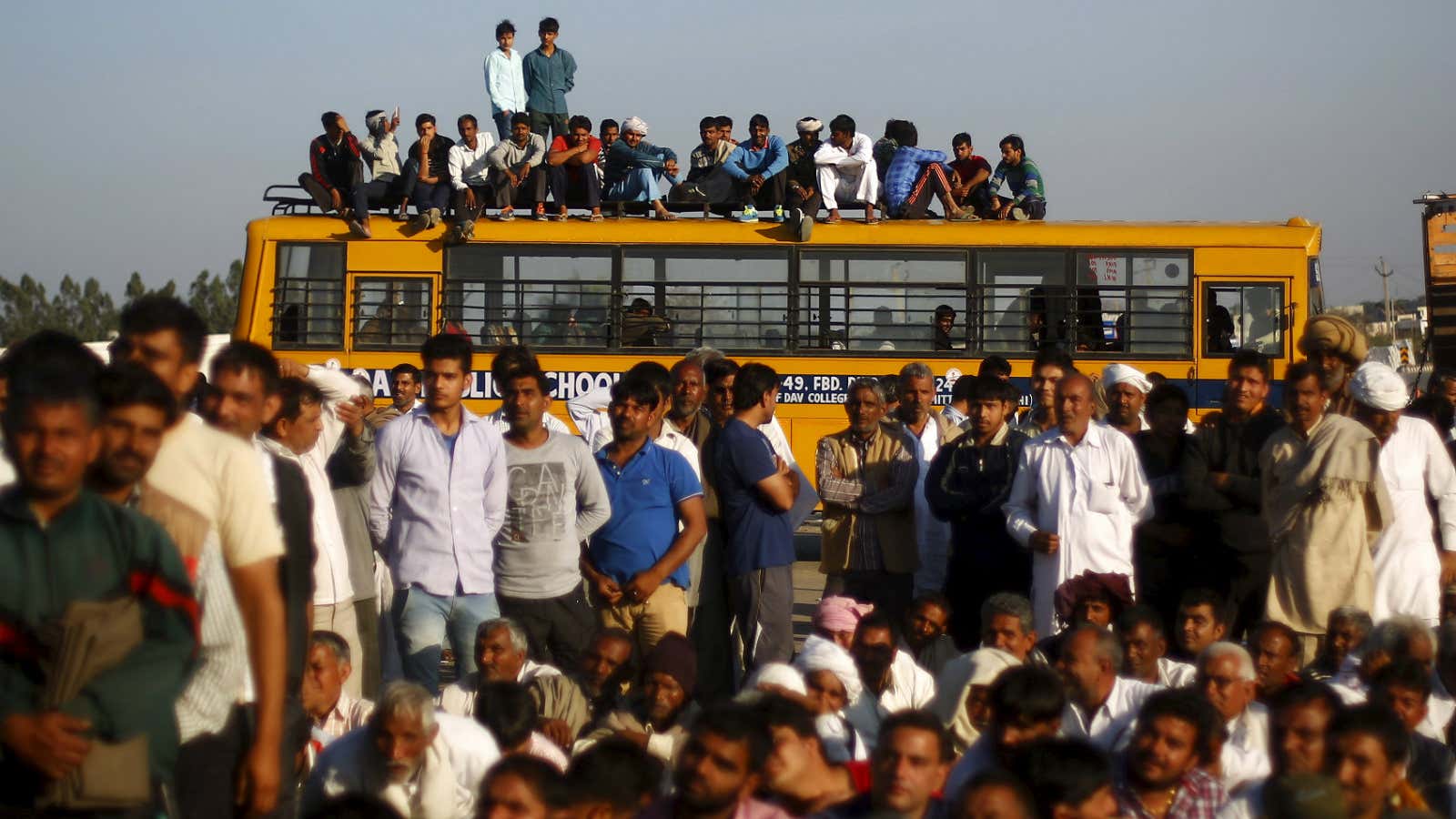It’s been five days since the northern Indian state of Haryana has been on the boil. Now, the chaos threatens to spill over.
Haryana, which borders New Delhi on three sides, houses over 250 Fortune 500 companies, a number of prominent Indian startups, and a large manufacturing belt. Some of the companies based in the state include Microsoft, Maruti Suzuki, Snapdeal and American Express, among others.
Since Friday (Feb. 19), however, caste-stoked protests in the state have brought the industry to a halt.
More than 10 people have been killed and 150 injured in protests across the state by members of the Jat community demanding reservations in jobs and education. The Indian government has sent in more than 3,000 army troops to impose law and order.
Traditionally agriculturists, Jats are among Haryana’s economically and politically well-off communities, forming 29% of its population. Yet, over the past two decades, they have demanded their inclusion in the Other Backward Class (OBC) category.
Under India’s reservation policy, this would give the Jats access to quotas in government jobs and at state-run educational institutes.
Last year, India’s supreme court removed Jats from the OBC list, a year after the previous government included them. Now, under pressure, the Narendra Modi government has decided to introduce a bill that will grant an OBC status to Jats. This legislation will be tabled during the next session of the Harayana Assembly.
The protests, however, have not ended, sending ripples across North India.
On Saturday, after protesters damaged equipment at the Munak Canal—an important source of water to Delhi—India’s capital city went dry. But the canal was “secured back” by the Indian Army today (Feb. 22). Meanwhile, the Delhi government declared Monday a holiday for schools and government offices.
Kapil Mishra, the city-state’s water minister, had tweeted on Feb. 20:
The airfare between Delhi and Chandigarh, Haryana’s capital, shot up more than 30 times to a staggering Rs99,000 in some instances, as the highway was blocked by protesters.
The monetary hit
Damage to key infrastructure in Haryana, including highways, railway lines, and water supply, has so far been huge.
“The ongoing violent agitation in Haryana has already dealt an estimated blow of Rs18,000-20,000 crore (nearly $3 billion) by way of loss to public and private property and halting trade, industry, small business and transport,” ASSOCHAM, an industry body, said in a statement on Feb. 21.
Since Haryana shares borders with Delhi, Punjab, Uttar Pradesh, and Rajasthan, the damage could spill over to other states, ASSOCHAM said, resulting in an additional “few thousand crores” of loss.
The statement added:
While the state government would assess the loss of damage to public property like burning of buses, private vehicles, railways stations, police stations, malls and hotels, the trade, industry and other businesses have come to almost complete halt in most of the districts, barring parts of Gurgaon, Rewari and other few areas on the Delhi-Jaipur National Highway number 8. The trade and industry loss is maximum in the worst-affected areas of Rohtak, Jhajjar, Bahadurgarh, Hissar, Bhiwani, Jind, Gohana, Sonipat, Kaithal, Karnal and Panipat.
Factories and manufacturing units located in the industrial towns of Manesar and Gurgaon have begun temporarily shutting down operations. Maruti Suzuki, India’s largest car maker, said on Feb. 20 (pdf) that it had suspended manufacturing at its Manesar and Gurgaon facilities. The company makes around 5,000 vehicles a day at these two locations.
“Owing to the agitation in Rohtak and the nearby areas, supplies of certain components have been disrupted,” the company said.
Other auto firms that have units in the state include Hero MotoCorp, Honda Motorcycles & Scooters India and Suzuki Motorcycle India. These firms have not yet announced any closure. Indian Railways has, meanwhile, reportedly lost more than Rs200 crore due to disruption of both passenger and freight trains.
Haryana, with a GDP of some Rs4.35 lakh crore, contributes about 3.5% to India’s economic output. Incidents such as these will likely hinder the state’s growth prospects. It could also severely affect its attractiveness as an investment destination, according to ASSOCHAM.
“The state administration has to be on top of the situation to control anti-social elements causing immense damage to the reputation of the state,” D S Rawat, ASSOCHAM secretary general, said in the statement.
